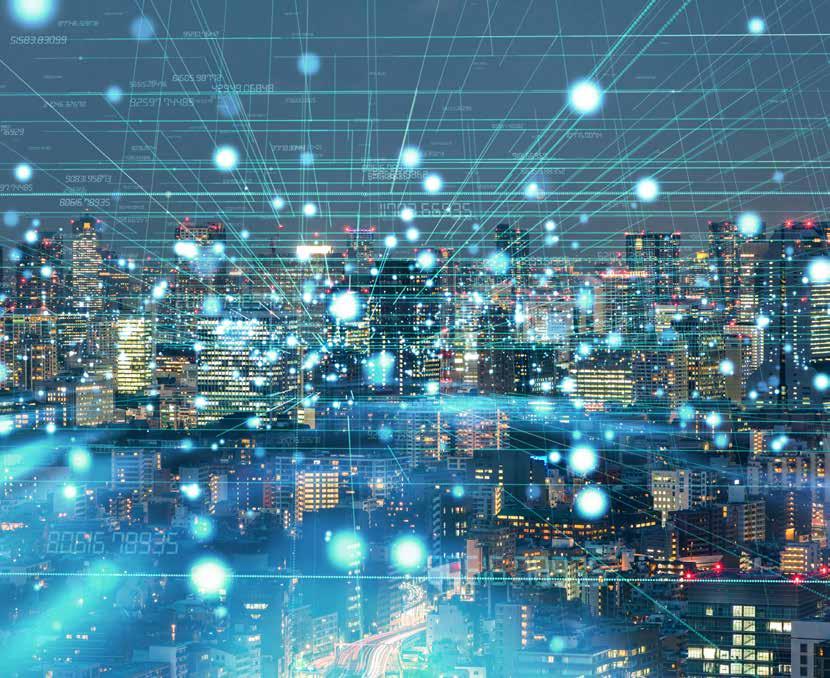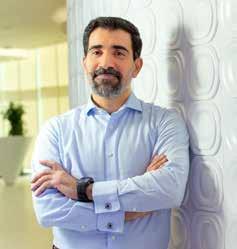
7 minute read
THE FUTURE OF CITIES
THE FUTURE OF CITIES HOW COVID-19 CRISIS COULD SPEED UP THE CREATION OF SMART CITIES IN THE MIDDLE EAST
The pandemic has become a catalyst for the development of cities around the world. Many cities are now leveraging their existing digital infrastructure to tackle the spread of the virus in urban areas, and experts argue the pandemic could provide the final push in how technology is used in smart cities. For example, South Korea and Singapore are using the power of smart city technologies to conduct contact tracing, using data from surveillance cameras and sensors to halt the spread of the coronavirus. Closer home, Abu Dhabi’s flagship smart city, Masdar City, built a high-volume testing facility within weeks as part of the Emirate’s pandemic management programme.
Advertisement
Though the global economic slowdown will have an adverse effect, IDC expects global smart cities expenditure to reach $124 billion this year, and KMPG estimates the Middle East and African smart cities market to touch $2.7 billion in another two years.
Large investments are going into technologies that enable smart cities, especially IoT and 5G, which are expected to accelerate the drive towards a smarter, digital world. “About 55 percent of the global population lives in urban areas and this number is expected to increase to 66 percent by 2050 according to a UN report in 2018. Overseeing the assets and operations of numerous large cities can only be economical and efficient only if they are automated and connected – and
Adrian Pickering


Lucky La Riccia

Marwan Zeidan
this is the underlying principle of smart cities. The development of smart cities relies on an integrated, intelligent, and interdependent network of a few essential smart city technologies, which include IoT, AI and 5G connectivity,” says Talal Shaikh, Director of Undergraduate Studies, Mathematical and Computer Sciences, Heriot-Watt University Dubai. Osama Al-Zoubi, Chief Technology Officer, Cisco Middle East and Africa, concurs that central to creating a smart city is the Internet of Things. “Whether we consider real-time air quality updates, autonomous vehicles and traffic monitoring, or more collaborative, digital learning environments, devices must be connected to the network and have the ability to constantly communicate with one another. In doing so, not only do these devices provide information, but also analytics upon which necessary actions can be taken to improve outcomes.”
Cisco’s Annual Internet Report (which predicts evolving trends in the digital landscape), anticipates that by 2023, there will be 2.6 billion devices and connections in the Middle East and Africa (MEA). This is up from 1.7 billion in 2018. And within 2.6 billion, machine-to-machine (M2M) modules will account for 30% of all networked devices.
“IoT drives the exchange of copious amounts of data as a network of connected physical devices and creates opportunities to converge physical appliances with digital capabilities through data analytics – elevating efficiency, CISCO’S ANNUAL INTERNET REPORT (WHICH PREDICTS EVOLVING TRENDS IN THE DIGITAL LANDSCAPE), ANTICIPATES THAT BY 2023, THERE WILL BE 2.6 BILLION DEVICES AND CONNECTIONS IN THE MIDDLE EAST AND AFRICA (MEA). THIS IS UP FROM 1.7 BILLION IN 2018. AND WITHIN 2.6 BILLION, MACHINE-TO-MACHINE (M2M) MODULES WILL ACCOUNT FOR 30% OF ALL NETWORKED DEVICES.
providing economic benefits, and improving quality of life,” says Adrian Pickering, EMEA regional manager at Red Hat. “Of course, the influence of IoT goes way beyond smart city development – the technology is essential to functionality and sustainability when development is completed. Besides linking smart energy, smart transportation, smart devices, and smart infrastructure, to name a few, IoT impacts every layer of a smart city, utilising IoT sensors, actuators, and other technologies to connect all components.”
With the increased volume and variety of data generated by IoT sensors and other advanced data collection methods, the need for high-capacity analytics tools is greater than ever before, according to Anas A. Abdul-Haiy, Director and Deputy CEO, Proven Consult. “Big data can be utilised to analyse data collected by finding patterns that are reflective of trends within cities. Big data is also used to find the causes of such issues and plan remedial actions. Thus, big data is a critical decision-making aid to Smart city governments,” he says.
Another critical piece of the smart city puzzle is 5G, which offers faster connections and bigger capacity at lower costs. Marwan Zeidan, Real Estate and Healthcare Segment Director, Middle East and Africa, Schneider Electric, explains why: “Connectivity is one of the core components in a smart city, as we have massive amounts of data that needs to be sent quickly and efficiently, to be analyzed and allow actionable insights. While wired connectivity could be prevalent in a smart city, 5G gives much more flexibility to deliver more services with devices that are in locations difficult to wire, or even to add new services that were not initially thought of. 5G also opens the door for bandwidth-heavy services that are required on the move, without limitation to speed and latency.” Lucky La Riccia, Head of Digital Services at Ericsson Middle East & Africa, says
Talal Shaikh

the biggest smart city infrastructure development this year is the commercial deployment of 5G, which will be the platform for tomorrow’s smart cities. 5G supports a high density of connected devices, extended coverage, mobility and delivers better energy efficiency comparable to today’s wired broadband.
Owing to the rise of IOT, the emergence of autonomous vehicles, the need for more efficient buildings, the number of endpoints in metropolitan areas is set to grow exponentially from millions to billions of connected devices.
Since many of these devices will be embedded in difficult to reach, often dangerous locations, wireless connectivity will be key in enabling flexible design and on-the-fly reconfiguration.
“Meanwhile, systems like driverless cars and drones will increasingly depend on real-time telemetry to function. 5G is more than the cellular network that provides connectivity to this plethora of technology – it is the connective fabric tying it all together, allowing operators to mine vast datasets for actionable and predictable insights that will be crucial in achieving sustainable urban growth,” Riccia from Ericsson adds.
Khaled Al Melhi, CEO of Injazat, opines all emerging technologies are essential in building the city of the future. From Artificial Intelligence (AI) to the Internet of Things (IoT), 5G, Virtual Reality (VR), Cloud and Cyber Security, the interplay between them all will make smart living possible.
Osama Al Zoubi


Prem Rodrigues
“One of these technologies in isolation is not enough to build a smart city, which is why it requires orchestrators to bring all these technologies together and build industries that subsequently enable entire countries such as the UAE to enter the Digital Economy. One of our smart cities’ initiatives, Hassantuk, successfully leverages an interplay of these emerging technologies to provide smart monitoring equipment for buildings across the UAE, offering AI-enabled maintenance and emergency services,” he says.
Homegrown standards
Though Dubai and Abu Dhabi figure in the index of top 100 smart cities in the world, many smart city frameworks are predominantly European. How can we adapt it to suit Middle Eastern countries?
Prem Rodrigues, director for the Middle East, Africa & India/SAARC at Siemon, thinks some cities in the Middle East are at par or not too far behind Europe. “Although Europe and the Middle East are different from each other, they have similar needs that can be tackled best through a common approach. The focus could be on areas where ICT, energy, and mobility overlap, and on offering solutions that can be transferable to other cities. Case studies from Europe will be much helpful, which will allow us to learn from their experiences. Developing a digital platform that integrates tools and enabling technologies as well as planning tools could help with the sustainable future development of the cities,” he says.
Shaikh from Heriot-Watt University says the Middle East is greatly invested in the digital age, especially amongst consumers. Building on a history of innovation, the region has the chance to transform itself into a leading digital economy—and to realise significant economic benefits—if it can rally stakeholders together to focus on developing the region’s governance, industry, investment, and talent. “Few Middle Eastern governments, including those of the UAE and Bahrain, have already begun implementing key digitisation initiatives. Other countries in the Middle East also have huge aspirations and are making significant progress. Though, in their attempt to encourage innovation and propel the public sector’s adoption of digital to the next level, they are facing implementation challenges, that include an inefficient governance structure for instance,” he says. Al-Zoubi from Cisco believes that technology is the ultimate enabler and unifying link, which makes people’s ambitions a reality. “However, in the context of a smart city, a city can only be classed as ‘smart’ if it truly works for its people. Top-down approaches to smart city planning often do not consider the idiosyncrasies, which may occur on a more granular, grassroots level. This is a mistake. A smart city requires constant iteration between its leadership, technology providers, end-users, and the wider public to create improved outcomes which can benefit the masses,” he says.










